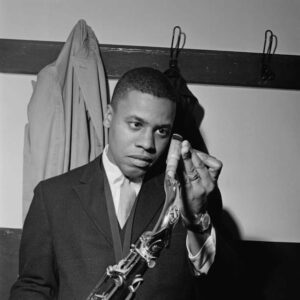Wayne Shorter Rest in Peace and Power by Oscar Deric Brown
追悼 ウェイン・ショーター by オスカー・デリック・ブラウン
text by Oscar Deric Brown
photo (above) © Mitsuhiro Sugawara
Thursday March 2nd, 2023
One of the Icons of Music, and Jazz, Wayne Shorter has transcended this earth, and now belongs to the Universe.
Having known Wayne personally, and remembering the many gifts he gave me as a mentor and friend. I would like to share some of his inspiration as a footnote, and witness to history.
Right now, I am shocked like everyone else, and it will be hard to imagine a world without Wayne Shorter.
Many years ago. October 6th 1991, We were at Miles Memorial at the, St. Peter’s Lutheran Church in midtown Manhattan. The Rev Jessie Jackson spoke about Miles, and I was in tears crying. Wayne turned to me and said,
We are like stardust. We do not belong to earth. But to the universe.
Miles’ death marked a change in the universe.
And I was sad because I knew I would never meet anyone like Miles again. and now Wayne Shorter.
Wayne, we love you.
Thank you for your everlasting gifts of wisdom, understanding, and music that will last forever.
It is very rare these days, even with all the new tech and software, the world is having a difficult time generating a true prolific genius like Wayne.
Just 3 generations ago there was no Social Media, or Internet, Streaming, or YouTube. And the average day seemed a bit longer.
Wayne Shorter was born on August 25th1933.
Had Wayne not discovered music, he could have given Albert Eisenstein a competition.
“Night Dreamer”
I first met Wayne in Los Angeles in 1967 during his time with the Miles Davis Quintet, at Shelly’s Manne-hole in Los Angeles. The band lineup was Buster Williams on Bass/ Herbie Hancock on Piano and a very young Tony Williams on Drums.The dressing room was so small, that the band would circulate and mingle with the audience in between sets.
The music was simply amazing,
Miles and Wayne were in perfect synchronization, playing the melodies mostly composed by Wayne.
After the end of the first set, I asked Herbie to introduce me to Wayne.And I remember asking him why they played everything so fast.
Wayne smiled and said, “we change the tempo every time we play the song.
The song in question was Footprints.
The band played a high-energy one and half hour set. The 2nd set was played as a Quartet, with Wayne at the center.
This was a night I would never forget.
Pure fire.
I would see this lineup 3 times between 1967 – 1968.
1971 – Weather Report
Joe Zawinul Keyboards and Wayne Shorter Ten & Sap Sax, Miroslav Vitous Bass / Eric Kamau Gravatt Drums,
The summer of 1971 Weather Report Summer Tour. LA / San Diego / San Francisco
That spring I was invited by Wayne to come to the rehearsal of Weather Report at Styler Sound Studio located in Hollywood.
Joe and Wayne were working new arrangements into the set list for the tour.
One song came to mind, Joe had developed a unique way of creating short motifs and later piecing them together to form a new composition centered around the theme “In A Silent Way”.
At the end of that rehearsal I was invited to travel with the band and help Joe each night set up his keyboards, which were, Fender Roads center and his first Oberheim modular synthesizer. The Oberheim was only used once because it was not yet ready for the road.
I will come back to that story later. But most important to me were my music study sessions regarding music and melody.
Wayne would tell me to ignore the math or structure but focus on the movement of the melody. The bottom note can always be substituted in real time.
Something they would call “Controlled Freedom”
I could go on for years talking about his contribution to music and the art form known as Jazz.
One of Wayne’s true gifts was supporting and encouraging another young artist to make the impossible, possible. We were both avid fans of reading comic books.
Wayne, Question
What did you think about the last episode of Superman?
Wayne: Even a person with all that power, must protect their innocence.
I am trying to put all my superpowers into one note.
John Coltrane did that also. The pure tone.
And that is one of the many things I think we will remember Wayne for.
His sound on the saxophone was unique.
I am so grateful I met Wayne, and that I was fortunate to live in a time of such great musical genius.
Wayne Shorter
Rest in Peace & Power
 Oscar Deric Brown
Oscar Deric Brown
Composer/Pianist
Executive Producer
ARTHUR AVENUE THE FILM
THE CONVERSATION PROJECT 2020
オスカー・デリック・ブラウン
BCIC 合同会社
BRILLIANT COLOR WORKS LLC
OFFICE ADDRESS: 1411 BROADWAY 16th FLOOR NEW YORK, NY 10018
2023年3月2日 木曜日
音楽とジャズのアイコンのひとつ ウェイン・ショーターが地球を去り宇宙の人となった。
ウェインを個人的に知る者として、彼が僕の心の師、友人として僕に与えてくれた多くの贈り物を思い出しながら、彼のインスピレーションのいくつかを歴史への証言として遺しておきたい。
時を遡ること 1991年10月6日。
僕らはマンハッタンはミッドタウンの聖ピーター・ルーテル教会で執り行われたマイルス・デイヴィスの葬儀に参加していた。ジェシー・ジャクソン師が語るマイルスを聴きながら僕は声を上げて泣いていた。 ウェインが僕を振り返りこう言った。
「僕らは星屑みたいなもんだよ。地球ではなく宇宙に居るんだ。マイルスの死は宇宙にひとつの変革をもたらしたんだよ。」
僕は悲嘆に暮れている。マイルスのような人物には二度と会うことはないだろうし、今度はウェイン・ショーターだ。
ウェイン、僕らは君を愛している。
久遠の智恵と理解、そして音楽を与えてくれたことに感謝している。
新しい技術やソフトウエアを持ってしてもウェインのような天賦の才に恵まれた真の天才を産み出すことは難しい。わずか三世代前にはソーシャル・メディアもインターネットもストリーミングもyoutubeも存在していなかったのだ。1日という長さが少しばかり長くなっているようだ。
ウェイン・ショーターは1933年8月25日に生を受けた。
ウェインが音楽の道に進むことがなかったら、アルベルト・アインシュタインと覇を競ったに違いない。
<ナイト・ドリーマー>
僕が初めてウェインと出会ったのは、1967年ロサンゼルスの「シェリーズ・マンホール」。マイルス・デイヴィス・クインテットで出演中のことだった。バンドのラインナップは、バスター・ウィリアムス(b)、ハービー・ハンコック(p)、そしてまだ若造のトニー・ウィリアムス(ds)。控室はとても小さくバンドは円陣を組んで座り、セットの合間は客も加わって混み合っていた。
演奏は驚異的だったとしか言いようがない。
マイルスとウェインが完全に一体となってウェインの楽曲を中心に演奏していた。最初のセットが終わって僕はハービーにウェインを紹介して欲しいと頼んだ。ウェインにどうしてそんなにテンポが速いのか質問したことを覚えている。ウェインは笑いながらこう答えたものだ。「いつもこの曲をテンポを変えながら演奏してるのさ」。この曲というのは〈フットプリンツ〉だった。彼らは1時間半のセットをエネルギーを込めて演奏し切った。2ndセットはウェインをセンターに据えカルテットで演奏した。
この日は僕にとって忘れられない夜となった。
純粋に燃え盛る火。
1967-1968の間このラインナップで3回聴く事になる。
1971 年 ウェザーリポート
ジョー・ザヴィヌル(key) ウェイン・ショーター (ts, ss) ミロスラフ・ヴィトウス (b) エリック・カマウ・クラヴァット (ds)
1971年夏 ウェザー・リポート・サマー・ツアー
LA/サンディエゴ/サンフランシスコ
その年の夏、ウェインからウェザー・リポートのリハーサルに招かれた。場所は、ハリウッドのスタイラー・サウンド・スタジオ。
ジョーとウェインがツアー用のセットリストに沿って新しいアレンジを仕上げていく。曲が頭に浮かぶと、ジョーが短いモチーフをひとつずつ展開していき、それらをまとめてテーマを中心に仕上げていく。かくして完成したのが <In A Silent Way>。
リハが終わると呼び出されてツアーに同行、毎夜、ジョーのキーボードのセットアップを手伝うことに。フェンダー・ローズを中心に初めてのオーバーハイム・モジュラー・シンセサイザー。しかし、当時のオーバーハイムはまだツアーには耐えられず一度使ったきり。
閑話休題。僕にとっていちばん重要だったことは音楽と旋律をめぐる学びだった。
ウェインのアドヴァイスは理論や構造は無視してメロディの動きに焦点を絞れ、ということだった。基音は常にリアルタイムで代替されうるということ。いわゆる「コントロールされた自由」に関すること。
僕は音楽そのものとジャズとして知られるアート・フォームに対するウェインの貢献についていつまでも語り継ぐことができる。
ウェインからの真の贈り物のひとつに不可能を可能にすべく若いアーチストを助け勇気づけることがある。
ウェイン、ひとつ質問がある。
スーパーマンの最後のエピソードをどう思っていたの?
ウェイン:あの大したパワーを持っている人間とて無垢な心を防御する必要なんだ。
僕は全力をひとつの音に込めようと努力し続けている。
ジョン・コルトレーンも同じ努力をした。純粋な音。
このことこそ僕らがウェインを忘れずにいるためのひとつのポイントなんだ。
彼のサックスの音はユニークだった。
僕はウェインに会えたことにとても感謝している。幸いにもウェインのような偉大な音楽の天才と同じ時代を生きることができた。
ウェイン・ショーターよ安らかに眠らんことを。(訳責:稲岡邦彌)
 オスカー・デリック・ブラウン Oscar Deric Brown
オスカー・デリック・ブラウン Oscar Deric Brown
1953年、ジョージア州トッコア・フォールズ生まれ。ピアニスト、キーボーディスト、コンポーザー、プロデューサー。LAとNYを往来しながら現在はNYに居住。サンタナ(1976~77)、ユッスー・ンドゥール(1990)などとのツアー、中川勝彦の『Human Rhythm』(1989)、『レインボウ・ロータス』(1995)などのアルバム制作、ヴィム・ヴェンダースの『Till the End of the World』 他3作の音楽制作など多彩な活動を展開。
https://www.facebook.com/oscarderic.brown?fref=ts







